engine MAZDA MODEL MAZDASPEED 3 2008 (in English) Owner's Guide
[x] Cancel search | Manufacturer: MAZDA, Model Year: 2008, Model line: MODEL MAZDASPEED 3, Model: MAZDA MODEL MAZDASPEED 3 2008Pages: 394, PDF Size: 7.62 MB
Page 134 of 394
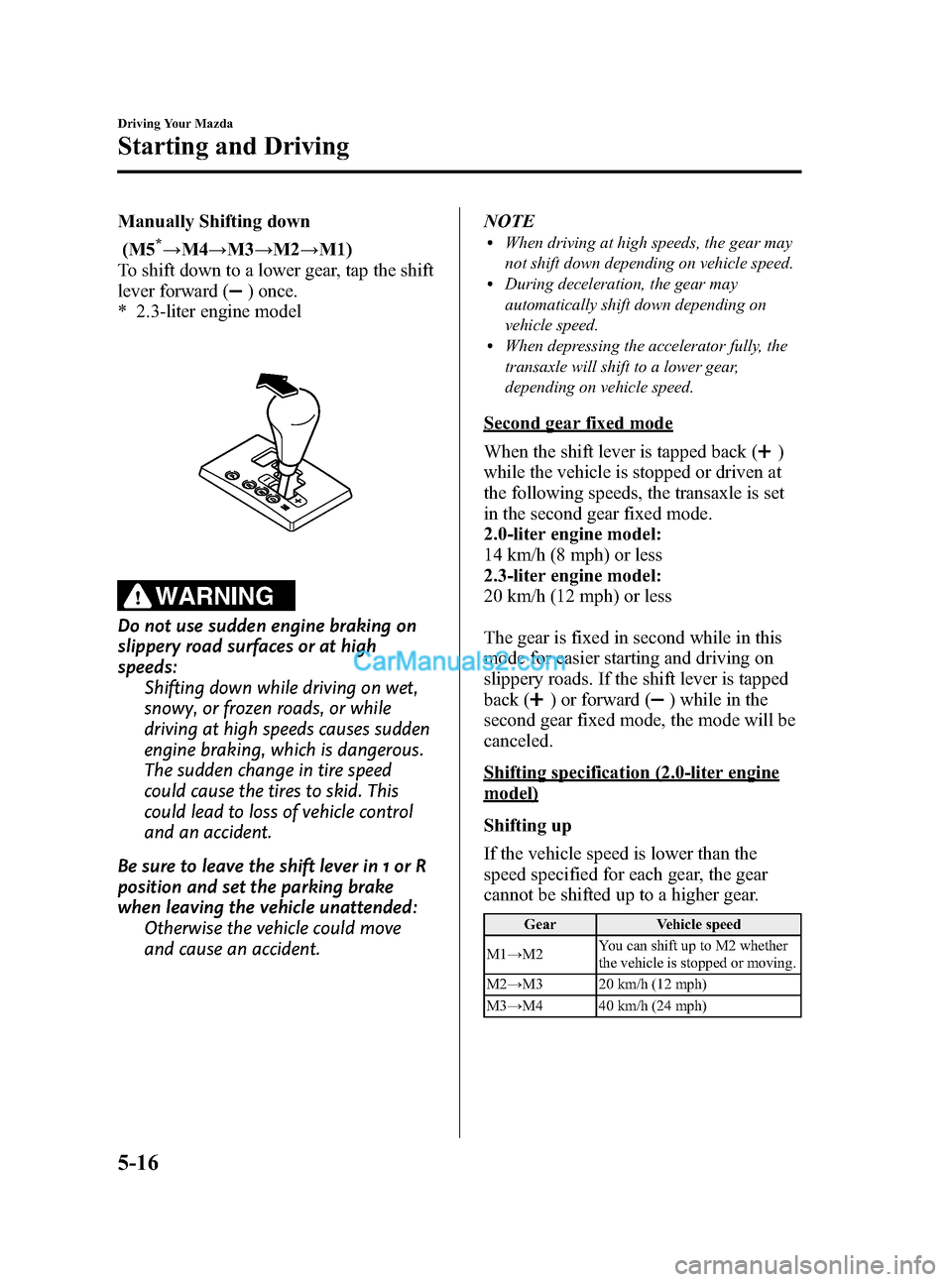
Black plate (134,1)
Manually Shifting down
(M5
*→M4→M3→M2→M1)
To shift down to a lower gear, tap the shift
lever forward (
) once.
* 2.3-liter engine model
WARNING
Do not use sudden engine braking on
slippery road surfaces or at high
speeds:
Shifting down while driving on wet,
snowy, or frozen roads, or while
driving at high speeds causes sudden
engine braking, which is dangerous.
The sudden change in tire speed
could cause the tires to skid. This
could lead to loss of vehicle control
and an accident.
Be sure to leave the shift lever in 1 or R
position and set the parking brake
when leaving the vehicle unattended:
Otherwise the vehicle could move
and cause an accident.NOTE
lWhen driving at high speeds, the gear may
not shift down depending on vehicle speed.
lDuring deceleration, the gear may
automatically shift down depending on
vehicle speed.
lWhen depressing the accelerator fully, the
transaxle will shift to a lower gear,
depending on vehicle speed.
Second gear fixed mode
When the shift lever is tapped back (
)
while the vehicle is stopped or driven at
the following speeds, the transaxle is set
in the second gear fixed mode.
2.0-liter engine model:
14 km/h (8 mph) or less
2.3-liter engine model:
20 km/h (12 mph) or less
The gear is fixed in second while in this
mode for easier starting and driving on
slippery roads. If the shift lever is tapped
back (
) or forward () while in the
second gear fixed mode, the mode will be
canceled.
Shifting specification (2.0-liter engine
model)
Shifting up
If the vehicle speed is lower than the
speed specified for each gear, the gear
cannot be shifted up to a higher gear.
Gear Vehicle speed
M1→M2You can shift up to M2 whether
the vehicle is stopped or moving.
M2→M3 20 km/h (12 mph)
M3→M4 40 km/h (24 mph)
5-16
Driving Your Mazda
Starting and Driving
Mazda3_8X41-EA-07F_Edition1 Page134
Wednesday, April 25 2007 1:5 PM
Form No.8X41-EA-07F
Page 135 of 394
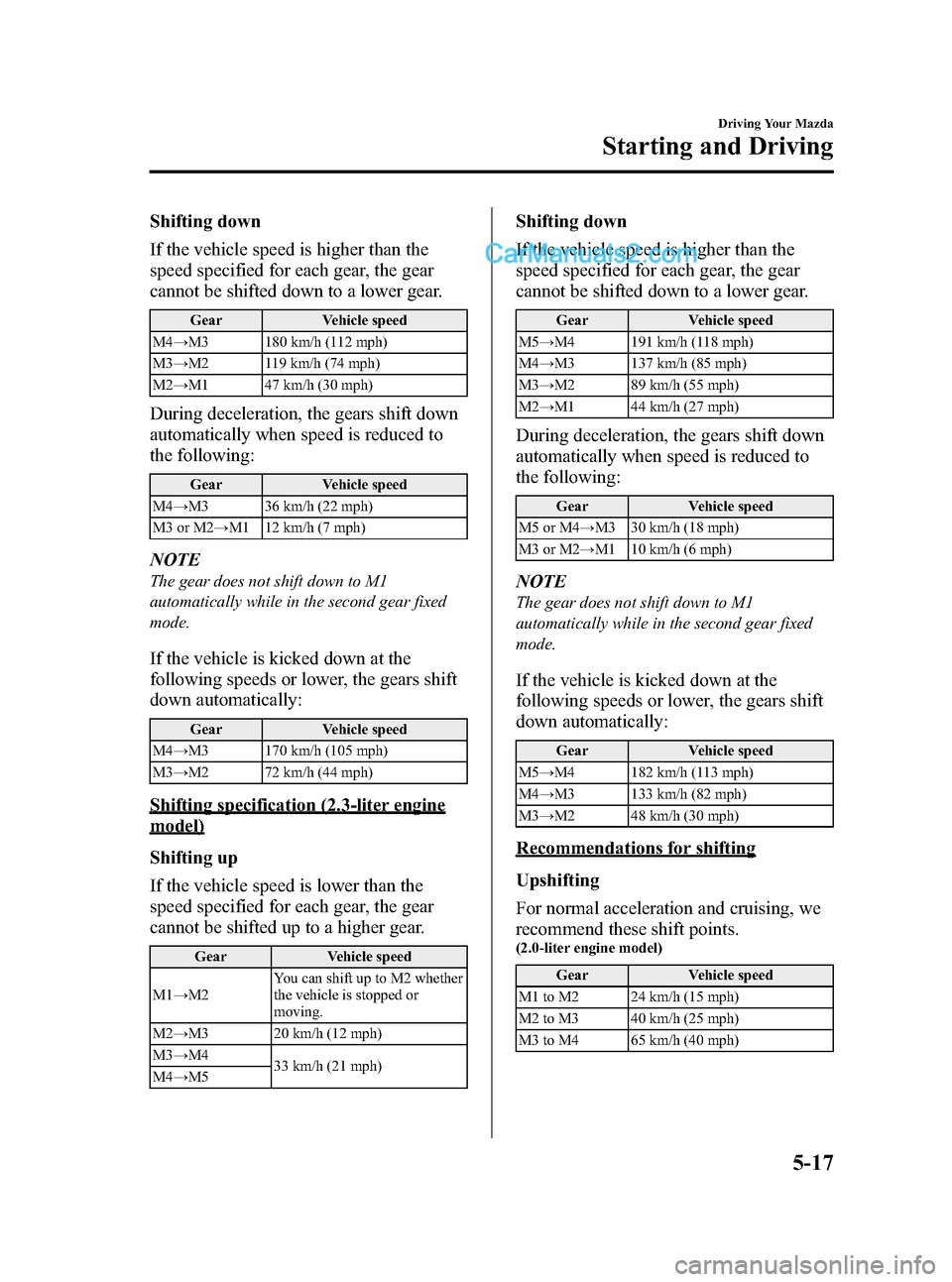
Black plate (135,1)
Shifting down
If the vehicle speed is higher than the
speed specified for each gear, the gear
cannot be shifted down to a lower gear.
Gear Vehicle speed
M4→M3 180 km/h (112 mph)
M3→M2 119 km/h (74 mph)
M2→M1 47 km/h (30 mph)
During deceleration, the gears shift down
automatically when speed is reduced to
the following:
Gear Vehicle speed
M4→M3 36 km/h (22 mph)
M3 or M2→M1 12 km/h (7 mph)
NOTE
The gear does not shift down to M1
automatically while in the second gear fixed
mode.
If the vehicle is kicked down at the
following speeds or lower, the gears shift
down automatically:
Gear Vehicle speed
M4→M3 170 km/h (105 mph)
M3→M2 72 km/h (44 mph)
Shifting specification (2.3-liter engine
model)
Shifting up
If the vehicle speed is lower than the
speed specified for each gear, the gear
cannot be shifted up to a higher gear.
Gear Vehicle speed
M1→M2You can shift up to M2 whether
the vehicle is stopped or
moving.
M2→M3 20 km/h (12 mph)
M3→M4
33 km/h (21 mph)
M4→M5
Shifting down
If the vehicle speed is higher than the
speed specified for each gear, the gear
cannot be shifted down to a lower gear.
Gear Vehicle speed
M5→M4 191 km/h (118 mph)
M4→M3 137 km/h (85 mph)
M3→M2 89 km/h (55 mph)
M2→M1 44 km/h (27 mph)
During deceleration, the gears shift down
automatically when speed is reduced to
the following:
Gear Vehicle speed
M5 or M4→M3 30 km/h (18 mph)
M3 or M2→M1 10 km/h (6 mph)
NOTE
The gear does not shift down to M1
automatically while in the second gear fixed
mode.
If the vehicle is kicked down at the
following speeds or lower, the gears shift
down automatically:
Gear Vehicle speed
M5→M4 182 km/h (113 mph)
M4→M3 133 km/h (82 mph)
M3→M2 48 km/h (30 mph)
Recommendations for shifting
Upshifting
For normal acceleration and cruising, we
recommend these shift points.
(2.0-liter engine model)
Gear Vehicle speed
M1 to M2 24 km/h (15 mph)
M2 to M3 40 km/h (25 mph)
M3 to M4 65 km/h (40 mph)
Driving Your Mazda
Starting and Driving
5-17
Mazda3_8X41-EA-07F_Edition1 Page135
Wednesday, April 25 2007 1:5 PM
Form No.8X41-EA-07F
Page 136 of 394
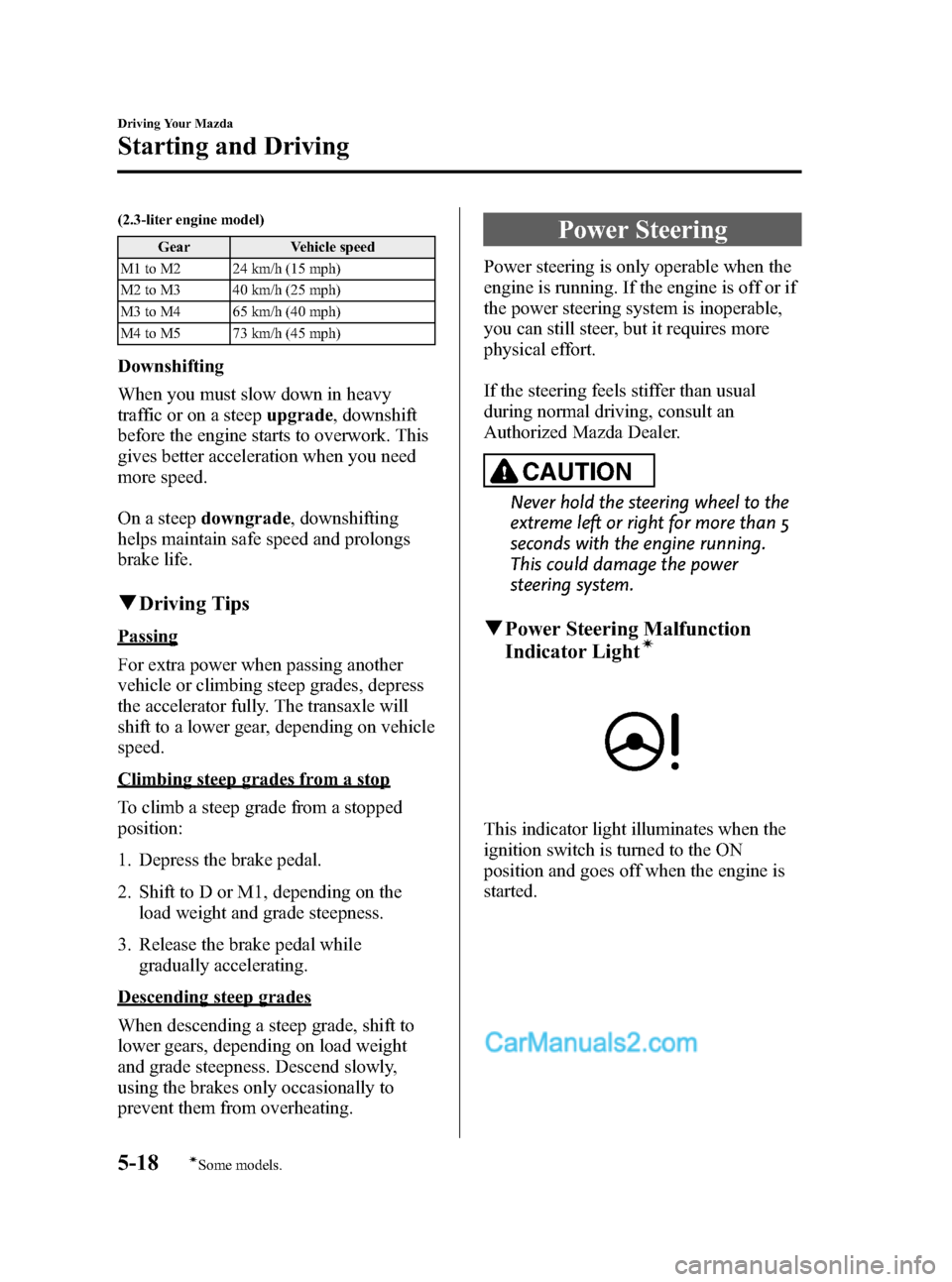
Black plate (136,1)
(2.3-liter engine model)
Gear Vehicle speed
M1 to M2 24 km/h (15 mph)
M2 to M3 40 km/h (25 mph)
M3 to M4 65 km/h (40 mph)
M4 to M5 73 km/h (45 mph)
Downshifting
When you must slow down in heavy
traffic or on a steepupgrade, downshift
before the engine starts to overwork. This
gives better acceleration when you need
more speed.
On a steepdowngrade, downshifting
helps maintain safe speed and prolongs
brake life.
qDriving Tips
Passing
For extra power when passing another
vehicle or climbing steep grades, depress
the accelerator fully. The transaxle will
shift to a lower gear, depending on vehicle
speed.
Climbing steep grades from a stop
To climb a steep grade from a stopped
position:
1. Depress the brake pedal.
2. Shift to D or M1, depending on the
load weight and grade steepness.
3. Release the brake pedal while
gradually accelerating.
Descending steep grades
When descending a steep grade, shift to
lower gears, depending on load weight
and grade steepness. Descend slowly,
using the brakes only occasionally to
prevent them from overheating.
Power Steering
Power steering is only operable when the
engine is running. If the engine is off or if
the power steering system is inoperable,
you can still steer, but it requires more
physical effort.
If the steering feels stiffer than usual
during normal driving, consult an
Authorized Mazda Dealer.
CAUTION
Never hold the steering wheel to the
extreme left or right for more than 5
seconds with the engine running.
This could damage the power
steering system.
qPower Steering Malfunction
Indicator Lightí
This indicator light illuminates when the
ignition switch is turned to the ON
position and goes off when the engine is
started.
5-18
Driving Your Mazda
íSome models.
Starting and Driving
Mazda3_8X41-EA-07F_Edition1 Page136
Wednesday, April 25 2007 1:5 PM
Form No.8X41-EA-07F
Page 137 of 394
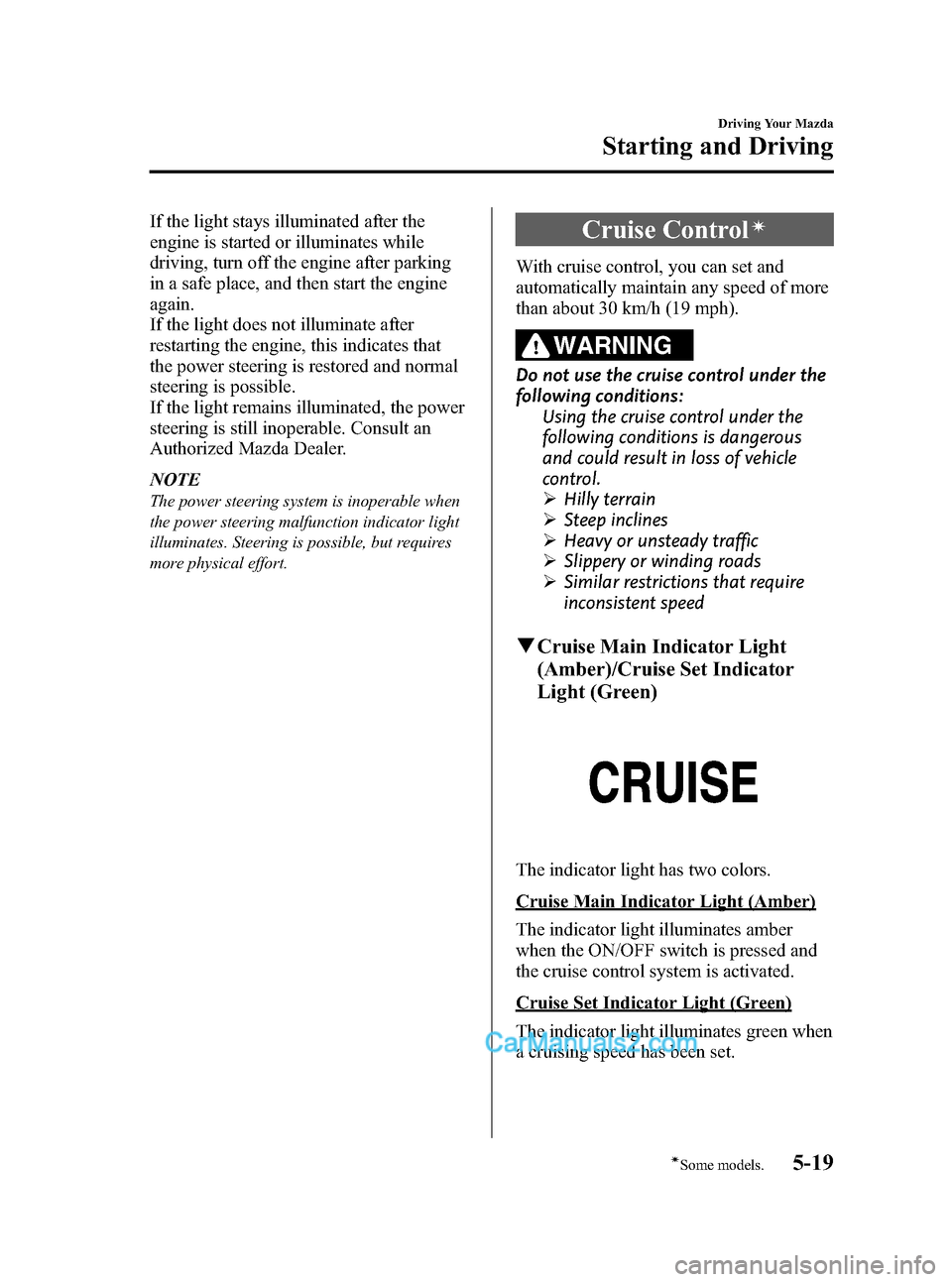
Black plate (137,1)
If the light stays illuminated after the
engine is started or illuminates while
driving, turn off the engine after parking
in a safe place, and then start the engine
again.
If the light does not illuminate after
restarting the engine, this indicates that
the power steering is restored and normal
steering is possible.
If the light remains illuminated, the power
steering is still inoperable. Consult an
Authorized Mazda Dealer.
NOTE
The power steering system is inoperable when
the power steering malfunction indicator light
illuminates. Steering is possible, but requires
more physical effort.
Cruise Controlí
With cruise control, you can set and
automatically maintain any speed of more
than about 30 km/h (19 mph).
WARNING
Do not use the cruise control under the
following conditions:
Using the cruise control under the
following conditions is dangerous
and could result in loss of vehicle
control.
ØHilly terrain
ØSteep inclines
ØHeavy or unsteady traffic
ØSlippery or winding roads
ØSimilar restrictions that require
inconsistent speed
qCruise Main Indicator Light
(Amber)/Cruise Set Indicator
Light (Green)
The indicator light has two colors.
Cruise Main Indicator Light (Amber)
The indicator light illuminates amber
when the ON/OFF switch is pressed and
the cruise control system is activated.
Cruise Set Indicator Light (Green)
The indicator light illuminates green when
a cruising speed has been set.
Driving Your Mazda
Starting and Driving
5-19íSome models. Mazda3_8X41-EA-07F_Edition1 Page137
Wednesday, April 25 2007 1:5 PM
Form No.8X41-EA-07F
Page 141 of 394
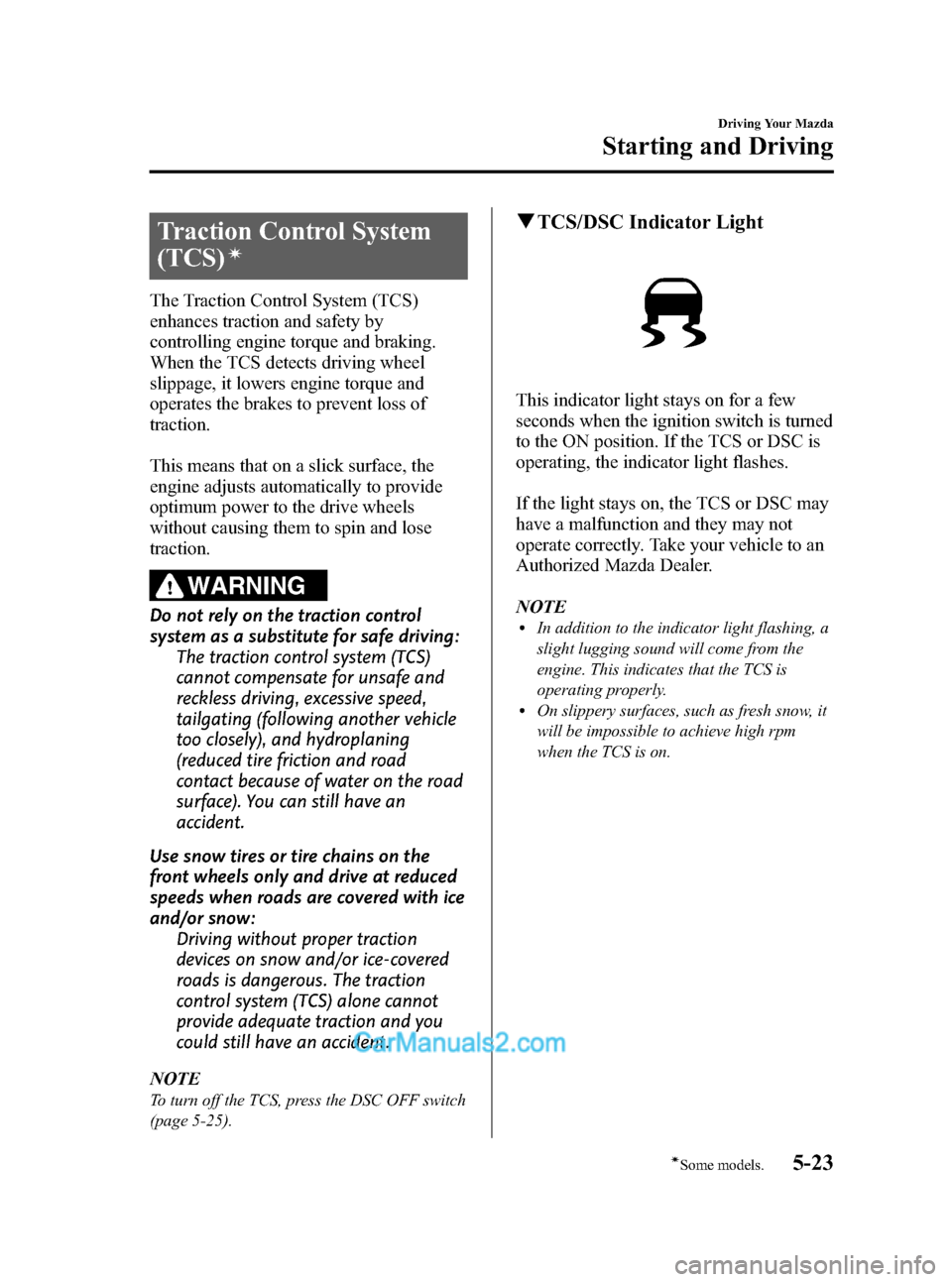
Black plate (141,1)
Traction Control System
(TCS)
í
The Traction Control System (TCS)
enhances traction and safety by
controlling engine torque and braking.
When the TCS detects driving wheel
slippage, it lowers engine torque and
operates the brakes to prevent loss of
traction.
This means that on a slick surface, the
engine adjusts automatically to provide
optimum power to the drive wheels
without causing them to spin and lose
traction.
WARNING
Do not rely on the traction control
system as a substitute for safe driving:
The traction control system (TCS)
cannot compensate for unsafe and
reckless driving, excessive speed,
tailgating (following another vehicle
too closely), and hydroplaning
(reduced tire friction and road
contact because of water on the road
surface). You can still have an
accident.
Use snow tires or tire chains on the
front wheels only and drive at reduced
speeds when roads are covered with ice
and/or snow:
Driving without proper traction
devices on snow and/or ice-covered
roads is dangerous. The traction
control system (TCS) alone cannot
provide adequate traction and you
could still have an accident.
NOTE
To turn off the TCS, press the DSC OFF switch
(page 5-25).
qTCS/DSC Indicator Light
This indicator light stays on for a few
seconds when the ignition switch is turned
to the ON position. If the TCS or DSC is
operating, the indicator light flashes.
If the light stays on, the TCS or DSC may
have a malfunction and they may not
operate correctly. Take your vehicle to an
Authorized Mazda Dealer.
NOTE
lIn addition to the indicator light flashing, a
slight lugging sound will come from the
engine. This indicates that the TCS is
operating properly.
lOn slippery surfaces, such as fresh snow, it
will be impossible to achieve high rpm
when the TCS is on.
Driving Your Mazda
Starting and Driving
5-23íSome models. Mazda3_8X41-EA-07F_Edition1 Page141
Wednesday, April 25 2007 1:5 PM
Form No.8X41-EA-07F
Page 142 of 394
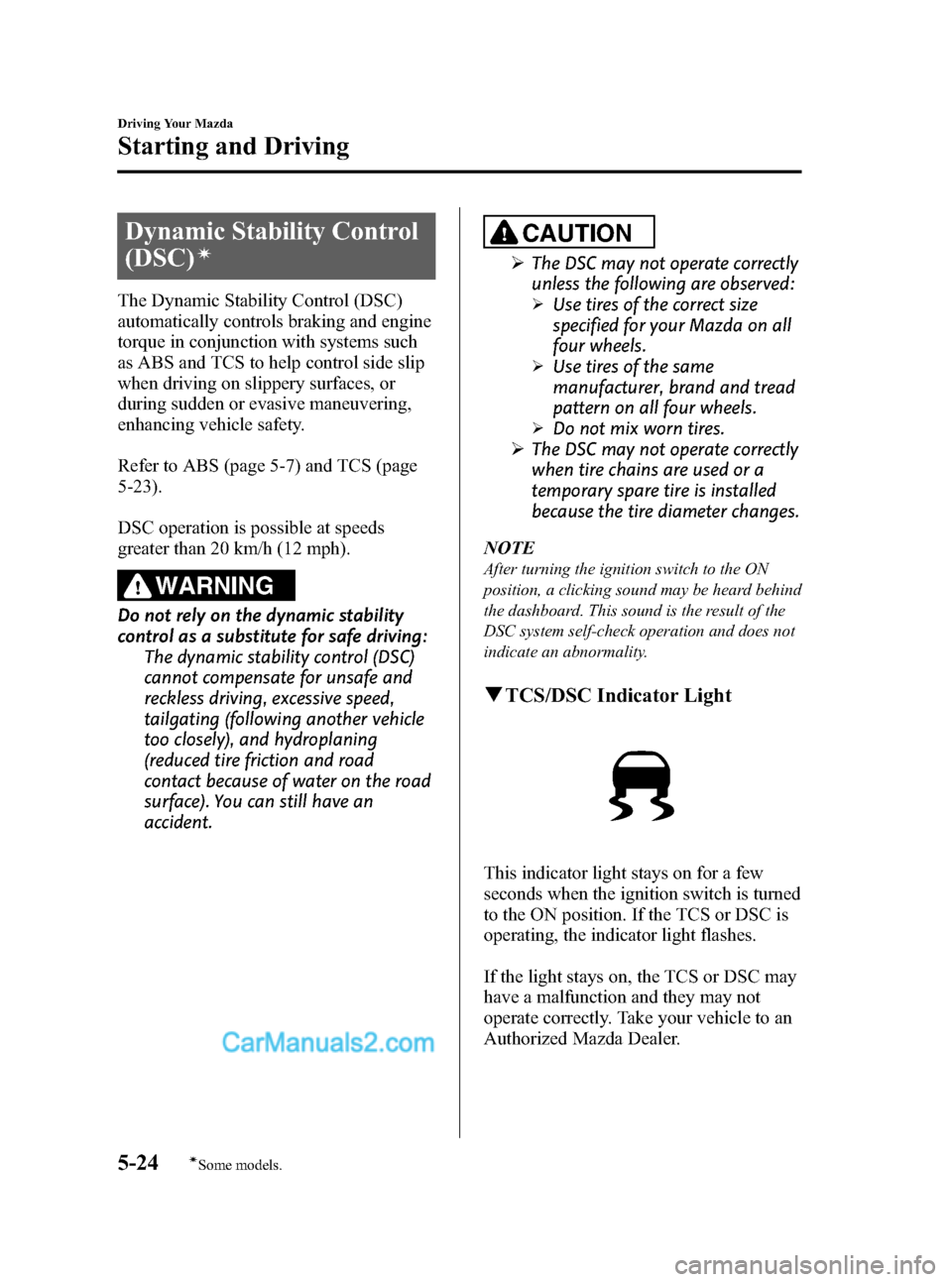
Black plate (142,1)
Dynamic Stability Control
(DSC)
í
The Dynamic Stability Control (DSC)
automatically controls braking and engine
torque in conjunction with systems such
as ABS and TCS to help control side slip
when driving on slippery surfaces, or
during sudden or evasive maneuvering,
enhancing vehicle safety.
Refer to ABS (page 5-7) and TCS (page
5-23).
DSC operation is possible at speeds
greater than 20 km/h (12 mph).
WARNING
Do not rely on the dynamic stability
control as a substitute for safe driving:
The dynamic stability control (DSC)
cannot compensate for unsafe and
reckless driving, excessive speed,
tailgating (following another vehicle
too closely), and hydroplaning
(reduced tire friction and road
contact because of water on the road
surface). You can still have an
accident.
CAUTION
ØThe DSC may not operate correctly
unless the following are observed:
ØUse tires of the correct size
specified for your Mazda on all
four wheels.
ØUse tires of the same
manufacturer, brand and tread
pattern on all four wheels.
ØDo not mix worn tires.
ØThe DSC may not operate correctly
when tire chains are used or a
temporary spare tire is installed
because the tire diameter changes.
NOTE
After turning the ignition switch to the ON
position, a clicking sound may be heard behind
the dashboard. This sound is the result of the
DSC system self-check operation and does not
indicate an abnormality.
qTCS/DSC Indicator Light
This indicator light stays on for a few
seconds when the ignition switch is turned
to the ON position. If the TCS or DSC is
operating, the indicator light flashes.
If the light stays on, the TCS or DSC may
have a malfunction and they may not
operate correctly. Take your vehicle to an
Authorized Mazda Dealer.
5-24
Driving Your Mazda
íSome models.
Starting and Driving
Mazda3_8X41-EA-07F_Edition1 Page142
Wednesday, April 25 2007 1:5 PM
Form No.8X41-EA-07F
Page 143 of 394

Black plate (143,1)
qDSC OFF Indicator Light
This indicator light stays on for a few
seconds when the ignition switch is turned
to the ON position.
It also comes on when the DSC OFF
switch is pressed and TCS/DSC is
switched off (page 5-25).
If the light stays on when the TCS/DSC is
not switched off, take your vehicle to an
Authorized Mazda Dealer. The dynamic
stability control may have a malfunction.
qDSC OFF Switch
To turn off the TCS/DSC, press and hold
the DSC OFF switch until the DSC OFF
indicator light illuminates.
Press the switch again to turn the TCS/
DSC back on. The DSC OFF indicator
light will go out.NOTE
lWhen DSC is on and you attempt to free the
vehicle when it is stuck, or drive it out of
freshly fallen snow, the TCS (part of the
DSC system) will activate. Depressing the
accelerator will not increase engine power
and freeing the vehicle may be difficult.
When this happens, turn off the TCS/DSC.
lIf the TCS/DSC is off when the engine is
turned off, it automatically activates when
the ignition switch is turned on.
lLeaving the TCS/DSC on will provide the
best stability.
Driving Your Mazda
Starting and Driving
5-25
Mazda3_8X41-EA-07F_Edition1 Page143
Wednesday, April 25 2007 1:5 PM
Form No.8X41-EA-07F
Page 150 of 394
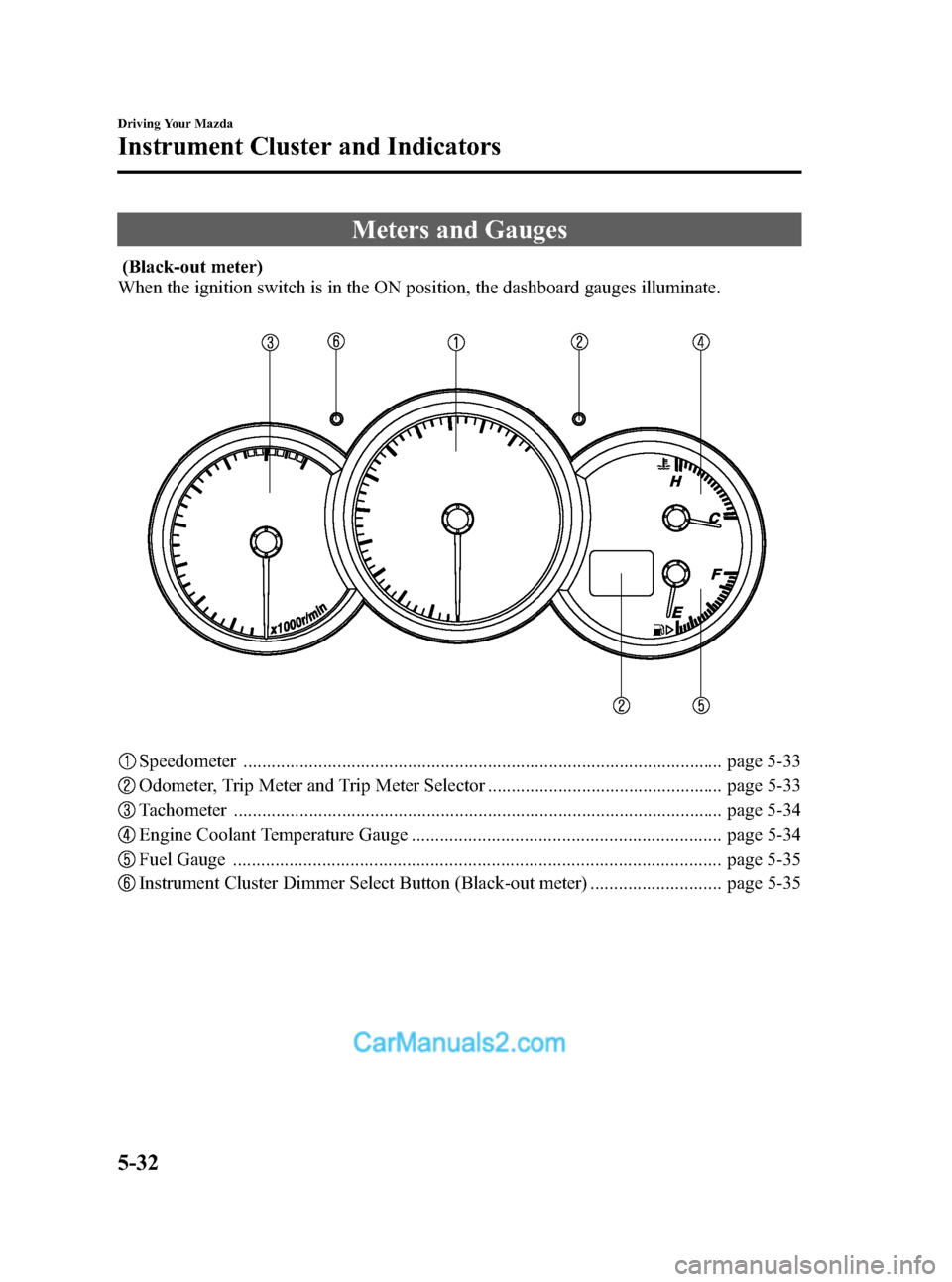
Black plate (150,1)
Meters and Gauges
(Black-out meter)
When the ignition switch is in the ON position, the dashboard gauges illuminate.
Speedometer ...................................................................................................... page 5-33
Odometer, Trip Meter and Trip Meter Selector .................................................. page 5-33
Tachometer ........................................................................................................ page 5-34
Engine Coolant Temperature Gauge .................................................................. page 5-34
Fuel Gauge ........................................................................................................ page 5-35
Instrument Cluster Dimmer Select Button (Black-out meter) ............................ page 5-35
5-32
Driving Your Mazda
Instrument Cluster and Indicators
Mazda3_8X41-EA-07F_Edition1 Page150
Wednesday, April 25 2007 1:5 PM
Form No.8X41-EA-07F
Page 152 of 394
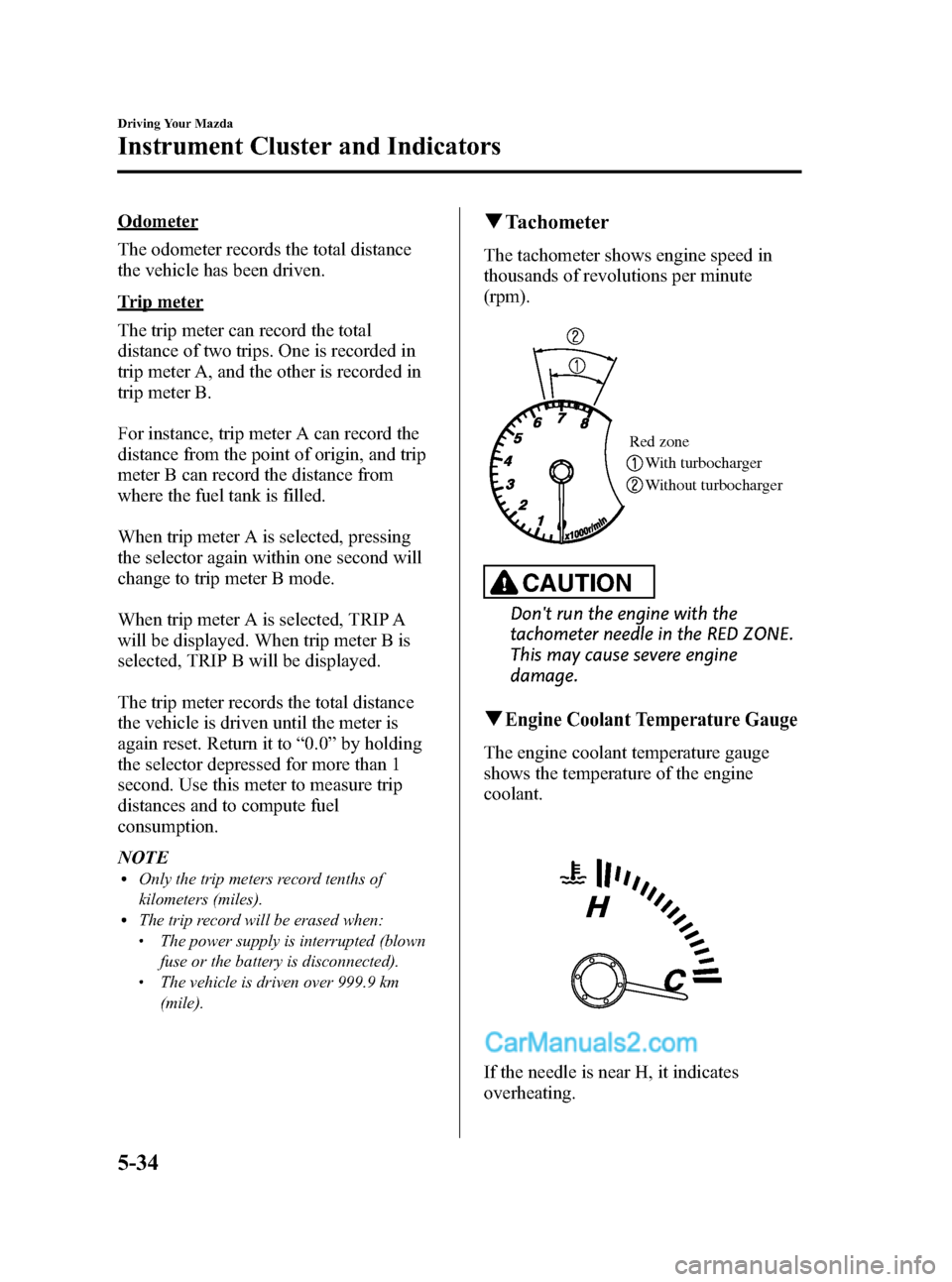
Black plate (152,1)
Odometer
The odometer records the total distance
the vehicle has been driven.
Trip meter
The trip meter can record the total
distance of two trips. One is recorded in
trip meter A, and the other is recorded in
trip meter B.
For instance, trip meter A can record the
distance from the point of origin, and trip
meter B can record the distance from
where the fuel tank is filled.
When trip meter A is selected, pressing
the selector again within one second will
change to trip meter B mode.
When trip meter A is selected, TRIP A
will be displayed. When trip meter B is
selected, TRIP B will be displayed.
The trip meter records the total distance
the vehicle is driven until the meter is
again reset. Return it to“0.0”by holding
the selector depressed for more than 1
second. Use this meter to measure trip
distances and to compute fuel
consumption.
NOTE
lOnly the trip meters record tenths of
kilometers (miles).
lThe trip record will be erased when:lThe power supply is interrupted (blown
fuse or the battery is disconnected).
lThe vehicle is driven over 999.9 km
(mile).
qTachometer
The tachometer shows engine speed in
thousands of revolutions per minute
(rpm).
Red zone
With turbocharger
Without turbocharger
CAUTION
Don't run the engine with the
tachometer needle in the RED ZONE.
This may cause severe engine
damage.
qEngine Coolant Temperature Gauge
The engine coolant temperature gauge
shows the temperature of the engine
coolant.
If the needle is near H, it indicates
overheating.
5-34
Driving Your Mazda
Instrument Cluster and Indicators
Mazda3_8X41-EA-07F_Edition1 Page152
Wednesday, April 25 2007 1:5 PM
Form No.8X41-EA-07F
Page 153 of 394
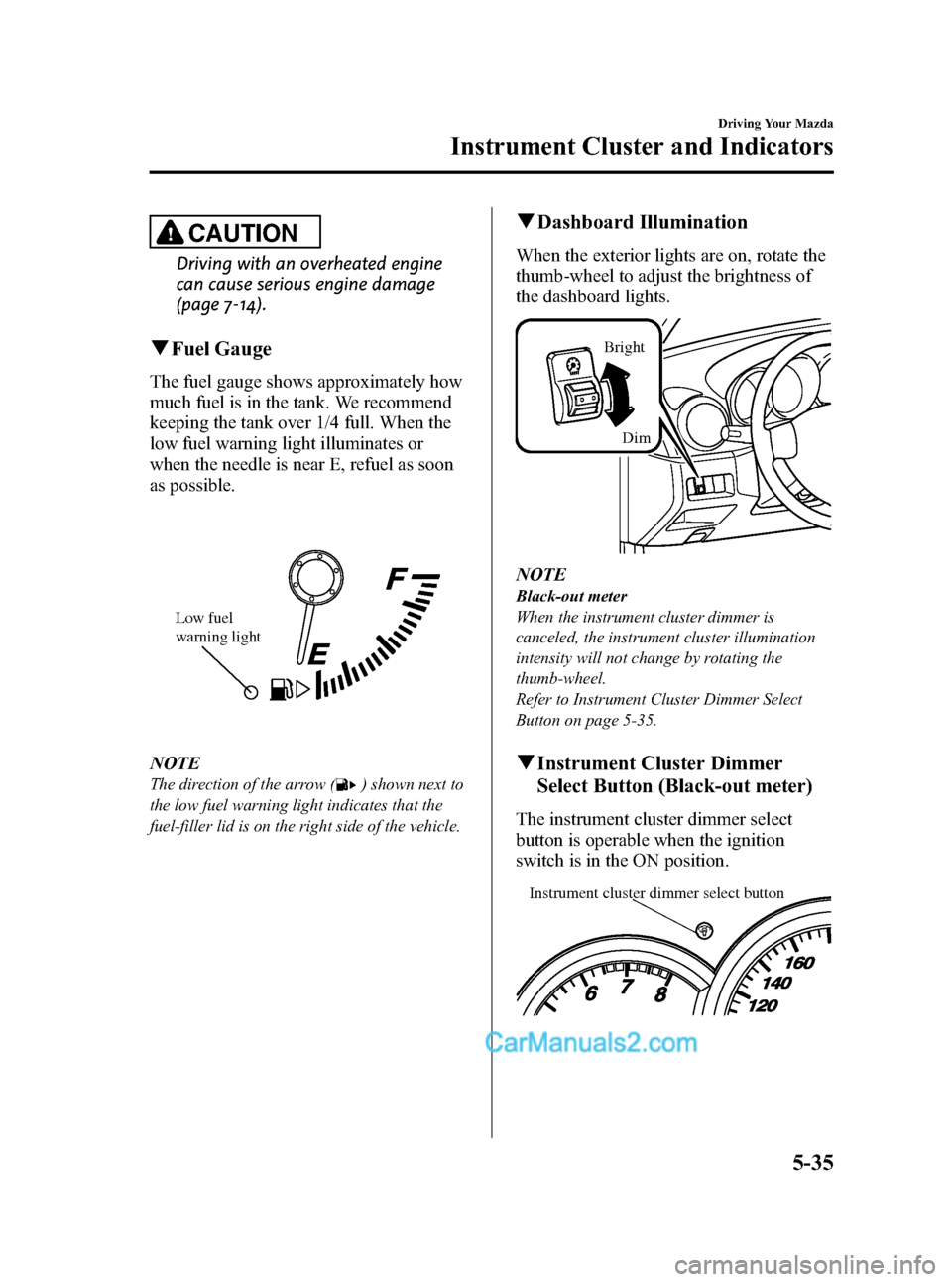
Black plate (153,1)
CAUTION
Driving with an overheated engine
can cause serious engine damage
(page 7-14).
qFuel Gauge
The fuel gauge shows approximately how
much fuel is in the tank. We recommend
keeping the tank over 1/4 full. When the
low fuel warning light illuminates or
when the needle is near E, refuel as soon
as possible.
Low fuel
warning light
NOTE
The direction of the arrow () shown next to
the low fuel warning light indicates that the
fuel-filler lid is on the right side of the vehicle.
qDashboard Illumination
When the exterior lights are on, rotate the
thumb-wheel to adjust the brightness of
the dashboard lights.
Bright
Dim
NOTE
Black-out meter
When the instrument cluster dimmer is
canceled, the instrument cluster illumination
intensity will not change by rotating the
thumb-wheel.
Refer to Instrument Cluster Dimmer Select
Button on page 5-35.
qInstrument Cluster Dimmer
Select Button (Black-out meter)
The instrument cluster dimmer select
button is operable when the ignition
switch is in the ON position.
Instrument cluster dimmer select button
Driving Your Mazda
Instrument Cluster and Indicators
5-35
Mazda3_8X41-EA-07F_Edition1 Page153
Wednesday, April 25 2007 1:5 PM
Form No.8X41-EA-07F